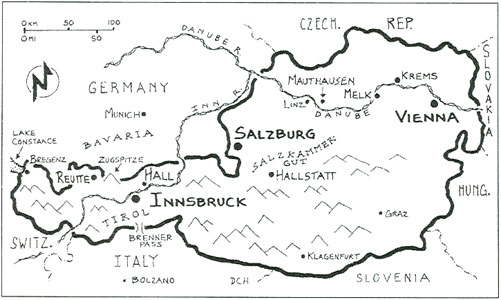
We boarded the train in Slovenia, but we never saw a ticket guy until after we crossed into Austria. He tells us that he can only charge us from the Austrian border, and we have just enough money for our tickets, it was our lucky day, my Birthday! Norine gives me a card, and inside is an ad for a Nintendo Wii, I'll have to wait a week before I can play it.
The countryside is scattered with little garden areas... a shed and a garden in a 20x40 plot, along with 20 or 40 others. These are the summer cottages of europe, a place to go tend a garden, and vacation with a small shed as a cabin.
Salzburg, Austria
We arrive at the train station and take a taxi to our hotel. The Hotel Wolf is over 500 years old, a cute little place right in the heart of the old city, with a beautiful view of the alley. At least noise wasn't going to be a problem here, and it had air conditioning too!
After quickly settling in, we head out to the streets of Salzburg and the famous Mozart square. Our hotel is just steps from the statue of Mozart, and the Hohensalzburg Fortress looming above the city.
The old town area rally should be called the Cathedral area. There is churches, cathedrals, and mosques all in a very small area, like rats in a maze of religion, we wind our way through the streets near to our hotel.
Hidden in the streets are some visual gems, a giant golden globe with a man on top, full period costumed girls giving out chocolates, it seems that Salzburg is full of these humorous and memorable sights.
Take the signs for example... before the days of numbered streets, signs were displayed so you knew what the store was, even if you didn't know how to read. Getreidegasse is the main pedestrian shopping street, as you look down the street you see all types of visual signs. The signs are ornate, and the images obvious, but the language and the corporate attempts to fit in are hilarious.
When I think of art in Europe, I think of amazing renaissance and impressionistic paintings, I think about amazing marble carvings like this one in front of the theater, what I don't expect is the lousy art filling the museum of Modern Art. After 15 minutes we had seen enough.
From the streets below the fortress we take the funicular up to the fortress to take a look around.
Since it is my birthday, we decide to splurge on the Mozart evening package. It starts with a 4 course dinner at the Fortress overlooking the city as the sun sets.
After dinner it is a Mozart concert in the Prince's quarters. 4 songs, 5 violins, a pianist, a bass, and a cello. It's 4 songs, 4 very long songs... and we learned a lot about Mozart concert etiquette. Each song is broken up into segments, with long dramatic pauses between the segments. Whatever you do, don't clap between segments, wait for the end of the song. An overly enthusiastic clapper receives a jab in the back and a nasty scowl from an old lady when he makes the mistake, we cautiously wait for others to start clapping for fears of attack from other old ladies. The old ladies didn't seem to care that the japanese tourists were falling asleep, one after another.
When the concert ends, it is dark outside. The rest of the audience heads to the funicular, and we are left alone to wander the fortress grounds. Wandering down the steep winding road to the town, it's not until we reach the bottom that we realize our funicular tickets were for both ways.
Making sure we don't enter any areas we weren't supposed to, we make it safely back to our room for the night. We have to get up early for a special tour in the morning, our only formal tour of the trip.
Saltmine tour
Before the bus arrives to pick us up, we have our free breakfast. We went for almost 4 weeks without doing a tour, but today is the day. We head into the Bavarian region of Germany. The driver jokes that we should hold our passport up against the window as we drive across a non-existent border. Our first stop is the Salzbergwerk, a salt mine. They dress you up in a set of overalls, load us onto a narrow train seated all in a row, and take us deep into the Salt Mines. Not deep enough, the rest of the way you have to use wooden slides.
Our guide is pure "colonel clink", a very stout german, the only english we get is from the english recorded voice at each of the info stops. After sliding into the main salt shaft we see the process used to take salt from the rock and make it into the white powder inside the salt shakers. Perhaps the most interesting is the underground lakes where they let the salt separate from the water. In the darkness we ride a boat across the mirror lake. It all goes tourism cheese when the laser show begins... funny to see, good for a laugh.
Before we board the train back to the surface, Colonel Klink gives us each a small salt shaker, full of salt from this mine. In the gift shop you can buy all assortments of Salt and Tacky souvenirs, what catches our eye is the Pringles. There is nothing quite like a can of Roast Ham or Roast Beef chips when you have a salty craving. Some of our tour group is dawdling in the tour shop, our bus driver is mad they aren't back when he told them, and goes to get them. This is why I hate traveling in tours, now our visit to the next stop will be cut short.
From Salzbergwerk we go to pick up the other half of our tour bus group at the base of the Kehlsteinhaus (aka The Eagle's nest). Kehlsteinhaus was the retreat of Adolf Hitler and his Nazi dignitaries, a stark contrast to the actual hills from "The Sound of Music".

The next stop was the cute little town of Berchtesgaden, a place to explore an old town square, and have some lunch. The town dates back to 1100, and was purchased by the Nazis in 1920 for their senior leaders to enjoy.
Just like in Salzburg, the use of signs for stores add a unique touch to the quaintness of the town, be it a toy store or a bakery.
The Berchtesgaden church is unique with it's 'Pretty in Pink' colour palette.
There is something up with Donkeys here, Jesus says PEACE from the top of a mule in the church, and in the town a disturbing fountain has a mule with a water stream coming out both ends.
After boarding the bus and crossing the German-Austria border back into Austria, Norine and I ask to be dropped off, rather than continuing on the tour, no problem. The bus stops on the highway, and lets us off, just a short walk from the Hellbrunn Palace. We'll catch a transit bus back to the hotel from here.
Hellbrunn Palace
Hellbrunn Castle (Schloss Hellbrunn) is an early Baroque castle, or palace, near the city of Salzburg, built in the early seventeenth century by Markus Sittikus von Hohenems, Prince-Archbishop of Salzburg. It was only meant for use as a day residence in summer, and the Archbishop usually returned to Salzburg in the evening. Therefore, there is no bedroom in Hellbrunn.
The view of the Salzburg Fortress from Hellbrunn
The castle is famous for its prank water fountains which are a popular tourist attraction in the summer months. These fountains were conceived by Markus Sittikus, a man with a sense of humour, as a series of practical jokes to be performed on guests. Notable features include stone seats around a stone dining table through which water sprays into the seat of the guests when the mechanism is activated. However, one seat doesn't spray water, that of the Archbishop.

Other features are a mechanical, water-operated and music playing theatre built in 1750 showing various professions at work, a grotto and a crown being pushed up and down by a jet of water, symbolizing the rise and fall of power. Throughout the gardens are displays and hidden fountains and sprinklers, antlers of deer, walkways, you're never safe. It should be noted that at all of these fountain areas, there is always a spot which is never wet, that's where the Archbishop stood or sat, today it's occupied by the tour guide.
As we are getting ready to leave the trick fountains area on our way to the Palace, we pass these mysterious balls. Don't ask me to explain this, but they look cool.
On the hillside there is a small building known as the Monatschlossl, or month-palace-let, as it was built during the period of one month after a visitor commented to the Archbishop that a building on the hill would improve the view from one of the schloss' windows.
We actually get the wettest when our sunshine turns to a terrible downpour, next time we bring our rainjackets when we go out! Now is a good time to make a run for the inside of the palace. Maybe it will have stopped when we're done.
... and then the rain stopped. We jumped into a bus and headed back into Salzburg.
Back in Salzburg
The public transit drops us right outside Mozart's old home, if he was born there, lived there, or even visited, they tell you about it.
Mirabell Palace and Gardens is a beautiful spot across the Salzach river from the old town centre and Fortress. It was built in 1606 for the Archbishop's Mistress.
The gardens are a mix of flowers, lawns, shrubs, fountains and statues, all aligned to the Fortress across the river.
We leave the gardens in search of a cold drink, even though it rained earlier, it's a scorcher now.
After crossing the river into the shopping area, we notice highlighted buildings. Their historic buildings are labeled, the Apothecary, and the house where Mozart was born.
Before heading back to our hotel we stop at an Internet cafe, a good 10 minutes worth of Birthday messages for me on Facebook (THANKS EVERYBODY!). After stopping at the Tourist Information office, we realize that the train options to Hallstatt will take most of the day, it's only 1 hour by car. No fancy dinner at a fortress tonight, but we did have some amazing Greek food on an outdoor patio across from our hotel. We check into renting a car, nobody has any cars, until finally we reserve a car with Hertz Rent-a-Car... but it's not going to be cheap.
When we arrive at Hertz to pick up our car, it's not there... they are very apologetic, and for making us wait, they upgrade our car. A Mercedes S-Class, all leather, GPS, Visual navigation, a german girls voice that tells us how to drive and what to do (in German), buttons everywhere, it even has a proximity meter when I'm backing up or pulling in to a spot. All that and it was 70€ less than we were told on the phone, this is luxury.
Hallstatt
Hallstatt is a cute little postcard town, perched on the hillside of Hallstatter See (Lake). It is also a Saltmine town, with a population of less than 1000 people.
It is full of small homes and buildings, nothing more than 2 or 3 floors, some building overgrown with fruit trees, and waiters running across the pedestrian only streets to serve the masses of tourists that come to see this town.
Anywhere along the shoreline you can see the unique stacked layout of the town, and the skyline dominated by the 2 churches in the middle of it.
Hidden in the middle of the town is a typical town square with a fountain, and peaking through is a waterfall that comes down the mountainside right into the centre of town.
It's a town full of quaint visuals, local crafts, flower boxes, and special signs.
After a leisurely lunch (not by choice), we head from the lakeshore to the hills overlooking the town using the funicular.
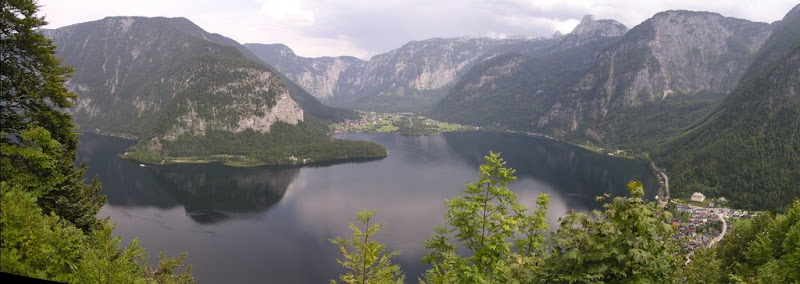
There is some trails, some sheep, and a restaurant overlooking the lake, but without views of the old town, we decide to head back to our car and continue on after checking out the Kalvariendberg kirche beside where we were forced to park, outside of the town limits.
After a comprehensive tour of Hallstatt we jump back into our car, get on the Autobahn and start heading to Vienna, usually between 130-170 km/h.
Traunkirchen on Traunsee (Lake Traun)
Along the way we pass scenic little towns along scenic little lakes, but the town of Traunkirchen was too cute not to stop.
It's like a little resort town with its lakeside locale, lakeside walking trail, and lakeside rent-a-boats. Perched above the town is a historic old church, with a gothic cemetery overlooking Lake Traun.
Melk
Melk is the home of the famous Stift Melk, a massive Benedictine abbey. It was the featured location of "The Name of the Rose". When we arrived in town we hunted down the places listed in our travel books, they were full, or not quite up to our standards. so after some hunting we ended up at the T.I., just as it was closing. Luckily they had an "auto-service" phone board outside, and we found an available hotel, with a good rate, and it was well above our standards, it even had a bathroom in our room.
Stift Melk looms above the town, Leopold I gave his 10th century castle to the Benedictine monks in 1089.
The town of Melk below the abbey is full of unique buildings, buildings like the Post office standout, but not as much as this Giant rabbit. No, it was not a toy store, just a rabbit holding the sign.
The size of the Abbey is apparent when you see it above the historic main street of the Rathaus. With an abbey of that size, a Parish Church is required in the middle of the town, apparently there is an event going on so we can't peek inside.
There is many signs of the towns history, including a 12th century wall, an Old fort, and its much newer 18th century town hall
As the sun sets on the town, we head back to our hotel for dinner. One of the problems with staying in a town dominated by an abbey is the church bells, all night long, add in a snorer and a mosquito, and it makes very a long night.
The long night means that means we wake up earlier on our Anniversary, and after a quick free breakfast, we head up to the entrance to the abbey... you have to pass through an odd art exhibit and we start to wonder what we have come to see, but then we enter the main abbey, amazing! 'Con Stantia Et Fortitv Dine'... I'll have to translate that some day

One of the rooms that is striking, is the Bibliothek, straight out of the movies.
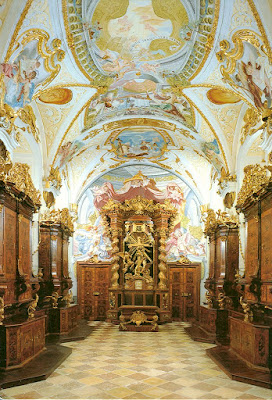
Another very impressive room is the Marble Hall (Marmorsaal) and its ornate ceilings.
In the center of the Abbey is a nice Courtyard, and the entrance to the main Church (Stiftskirche).
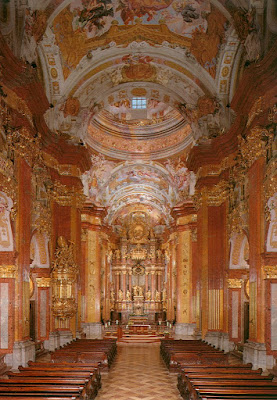
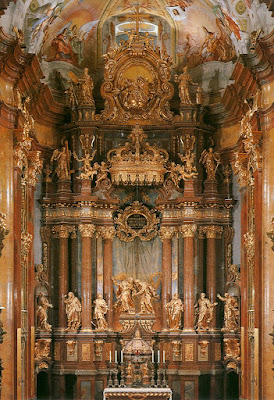
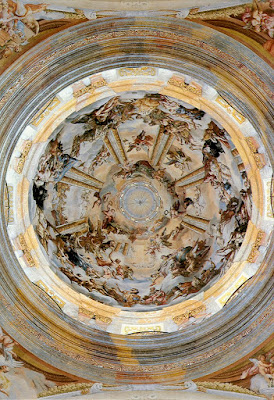
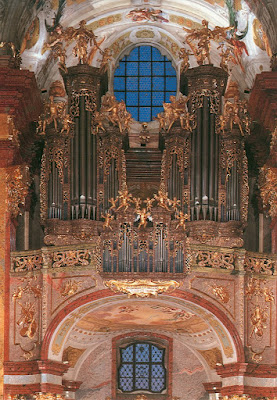
Inside of the Stiftskirche a full morning service is going on, and I am told that I can't take pictures, but I'm not using a flash so what's the harm? I know it's so they can sell more postcards, so from the hip I take some illegal pictures, and I buy a couple postcards to make up for my sins 8-).
In the Stiftspark (gardens of the abbey) is a small barocker Gartenpavilion (Baroque Garden Pavilion). It is a beautiful building, with beautiful gardens on the outside, and beautifully painted walls on the inside.
We need to get our Mercedes back to Hertz in Vienna by noon, so it's back into the car and onto the Autobahn, at these speeds it wouldn't take long to get into Vienna.
Back in Vienna
Vienna is designed to be driver unfriendly, luckily we had a navigation system to wind us into the city. Even using the GPS, and having our German voice tell us what to do, we got a little lost trying to find the Hertz office, bye-bye nice car. Pension Nossek is down the main pedestrian shopping streets of Kartner and Graben Strasse. It's a very hot 15 minute walk to our hotel, it's about 35 celsius (95 Fahrenheit). This Pension/Hotel is right in the heart of the old city, across from St Stephens, and it's history is amazing... as you enter a sign is proudly displayed...
Wolfgang Amadeus Mozart
27.1.1756 - 5.12.1791
Mozart lived here from the early September 1781 to the late July 1782
He completed "The Abduction from the Seragilio" in this apartment
Schloss Schönbrunn
Schönbrunn Palace was originally know as Katterburg in the 14th century, a water-mill and vineyard would become the royal hunting grounds and nature preserve built out by Emperor Maximillian II. For hundreds of years it was built up with more gardens, and the preserve was filled with more exotic animals. After the enclosed gardens of the Katterburg were destroyed by Hungarian forces in 1605, the damage was provisionally repaired and the estate was subsequently used by Emperor Matthias for hunting expeditions. According to a legend, it was on one of these expeditions in 1612 that Matthias discovered the Fair Spring (Schöner Brunnen) that would give the estate the name it uses now. The receptionist gave us directions, and we took a streetcar then the underground subway to the Palace. It's boiling hot now, nearing 40 (104), as we enter the massive courtyard in front of the palace.
Using our handheld audio sets we squeezed past each of the large tour groups going room to room.
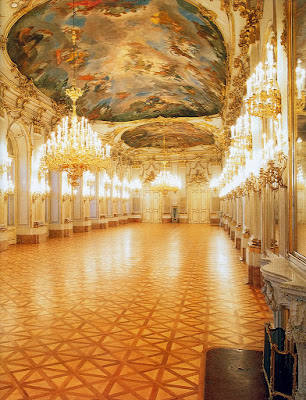
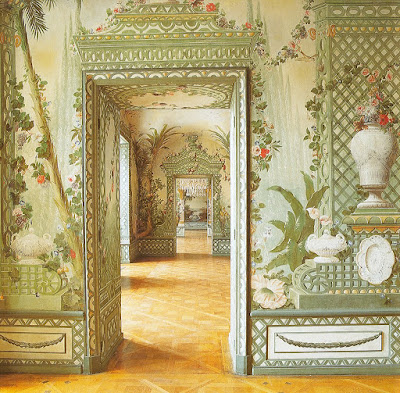
In one of the rooms we ran into Rick Steves, he is taller and more grey than we have noticed on his PBS travel show. His book was in our bag, but he wandered away before we could get him to sign it. Obviously him and his producer were planning their next show.
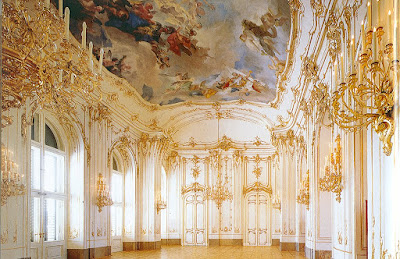
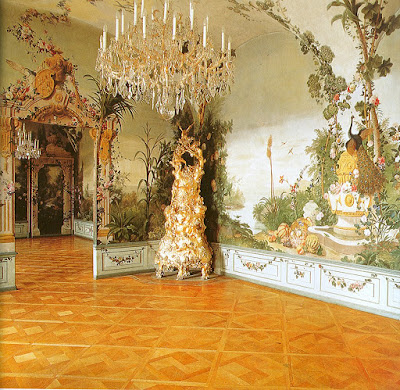
After watching a demonstration of how to make Apple Strudel, we enjoyed our Strudel snack and a cold Iced Tea, then headed into the Privy Garden
The Privy gardens are separated from the rest of the Palace grounds, and contain a collection of citrus trees and sculpted garden beds.
From the Gardens we walked throughout the grounds of the palace, and up the hill to the Gloriette.
The Gloriette is a unique structure at the peak of the hill where the Palace was supposed to be built. It's capped with a Palace viewing platform surrounded by Statues of an Imperial Eagle and trophies, and a marble vase perfect for crows.
From the Gloriette you wind your way back down the hill past fountains and more gardens.
A couple of landmark locations include the Palm house greenhouses and a maze garden.

After spending a hot afternoon at Schloss Schonbrunn we took the 'U' (underground) and headed back to our room. We didn't get their until after 6:30.
Vienna
It's still boiling hot, so we have an unintentional snooze with a breeze blowing through our room, and head out past St Stephens for our anniversary dinner around 9.
Our 20th anniversary dinner would be at the Beim Hofmeister Restaurant, a historic streetside restaurant that has been serving since 1880. We had a very good meal, I enjoyed some Veal Medallions and Apple Fritters, the whole time being watched by a cute little beggar at our table. Even late at night it's still hot, there's no wind, and the fan is on high in Mozart's room.
We get up for our free breakfast and head out past what seems to be the patron saint of pigeons, and head into St Peters church right across from our hotel.
Today would be a great day to explore some of the sights we saw in the rain at the beginning of our trip, and since it was the last full day of our vacation we would check out a few new areas too.
Since it is so close, we head back through the gateway to St Michael's square and into the Hofburg.
Jozefsplatz, St Michael's square and the Hofburg are all surrounded by amazing statues, even the guard booths are made of marble and topped with Roman style helmets. I think this guard must have been in the bathroom next to his guardhouse.
We revisited some of our favourite sights, like the amazing Parlament buildings and the Rathaus.
Although it is covered in scaffolding the Votiv Church is still an impressive building, today we would have a chance to check the inside of a historic church in mid restoration.
From repeating the highlights, we head to some new areas, we wander towards the Danube river, past a fort like structure that turns out to be Police HQ, and right into a bad part of the hood.
As we wander along the river we slowly move away from the graffiti and trash and into more interesting areas, a row of riverside greek restaurants, a great place to stop for cold drinks and a tasty meal. There is a bit of a language barrier for the menu, but the waiter speaks rough english. After the meal and a couple more cold drinks the waiter asks us how we describe Norine's lunch in English... "Deep Fried", he is happy to be able to explain this to his future customers.
We wander past some great historic structure such as the Eagle guardian, and a very old vine covered church, and then we see a very strange sight, a public swimming barge. Tied to the shore is a large barge with a sunning deck and a bright blue pool.
From one form of recreation to another, we head towards the Riesenrad (giant Ferris Wheel) built in 1897. Originally it had 30 cars, but after being severely damaged in the second world war they only rebuilt 15. It has appeared in numerous films such as The Third Man and The Living Daylights.
The theme park that surrounds the Riesenrad is called The Prater, it has been amusing the Austrians and tourists since 1766.

The panoramic view of Vienna from the top of the Riesenrad
From the Prater we took the 'U' back to the hotel, and spent the rest of the afternoon shopping along the pedestrian shopping streets. As we walked along we heard a clatter of tambourines, and watched in awe as a parade of Hare Krishnas wander past the silver statue people.
After a long hot day, the clouds seem to be rolling in, perfect, it finally cools down a bit, and we have a lovely Italian dinner with loads of Garlic. Perfect protection for our flight home. As we get ready to leave a few people are walking by with umbrellas, a few stray drops, but a nice cool walk back to our room, and a cool wind blows through the room on our last night in Europe.
We get up early and head to the airport, it's a short flight to Dusseldorf, and a short wait for the long flight home. Eastern Europe was an incredible mix of history, culture, nature and interesting experiences. From the beautiful city of Prague, to the amazing people and sights of Croatia and Slovenia, it was an unforgettable trip full of memories we won't soon forget.
